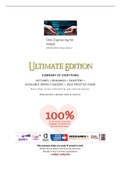Summary
Complete Summary for Data Engineering for MADS (Lectures, Readings, Book Chapters, Weekly Quizzes and Practice Exam)
- Course
- Institution
- Book
The best complete summary for Data Engineering for MADS (EBM213A05), it includes: Lectures, Readings & Book Chapters (Mandatory + Optional), Weekly Quizzes and the latest Practice Exam. Enhanced with a dynamic table of contents and meticulous organization for readability and easy studying. 100%...
[Show more]




